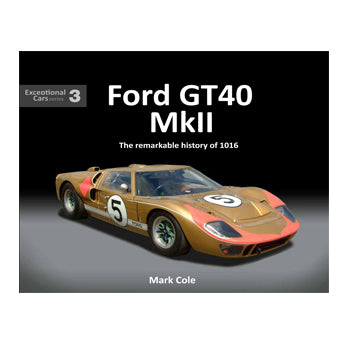
The bad omens that plagued Ford before its GT40 Le Mans 1-2-3
Ford went into a third consecutive year of trying to win the Le Mans 24 Hours in 1966, still hell-bent on a mission declared when its attempt to buy-out Ferrari had been snubbed. This was a bitter rivalry in which Ford was being humiliated. Ferrari had scored a 1-2-3-5-6 at la Sarthe in ’64, when all three GT40s failed to finish, then Ferrari racked-up another 1-2-3 in ’65 while not one of the six GT40s lasted the distance. When at last the tables were turned in ’66, Henry Ford II was trackside to relish the revenge and GT40 Mk IIs crossed the line together in first, second and third places in a formation finish choreographed to rub Enzo’s nose in it.
First of the three Fords, if only just, was the Shelby-America run car of Kiwis Bruce McLaren and Chris Amon, with another Shelby-America entry, driven by Briton Ken Miles and Kiwi Denny Hulme, in second place. It was the distinctive gold-and-pink Mk II run by NASCAR team Holman & Moody that sealed the clean-sweep. Driven on this occasion by Formula 1 driver Ronnie Bucknum and NASCAR ace Dick Hutcherson, this was chassis number P/1016, the central character in the latest addition to our Exceptional Cars Series, Ford GT40 Mk II - The remarkable history of 1016. This fascinating book by Mark Cole recalls, among so many other stories, how Bucknum played a big part in developing the original 4.7-litre Ford GT into the winning Mark II with its monstrous 7-litre V8.
Half-a-century later, the collective memory of Le Mans ’66 is inevitably of three GT40s crowding the finish line together, a recollection vividly refreshed by some of the most iconic photographic images in motorsport history. Not so well remembered, however, is how unlikely this picture-perfect result had seemed in the months leading up to the race, when anyone even slightly inclined towards superstition might have feared Ford was plagued by demonically bad omens.
The first of these dark signs materialised with gruesome ugliness in the Sebring 12 Hours in late March, when a Comstock Racing GT40 Mk I veered off the track after its gearbox seized, crashed into a ditch, barrel-rolled, hit a telegraph pole and burst into flames. Its driver, 32-year-old Canadian Bob McLean, died in the inferno.
In the next vicious slap from Lady Luck, at Le Mans Test Weekend in April, one of the Holman & Moody Mk IIs aquaplaned on the wet pits straight, skated down an escape road, and slammed into a pile of construction sand which shouldn’t have been there before bouncing back across the road into a retaining barrier. The car folded up and its driver, 46-year-old American Walt Hansgen, sustained injuries so severe he died five days later.
In the aftermath of Hansgen’s accident, the Ford factory withdrew its entry from that month’s Monza 1,000Km, leaving the Ferrari 330 P3 of John Surtees and Mike Parkes to take victory. Then Ferrari’s 330 P3 won again at the Spa 1,000Km in May, beating a Mk II into second place.
The arrival of June brought no respite. On the fourth day of that month one of Ford’s most prominent GT40 development drivers, Texan Lloyd Ruby, was piloting his single-engine Beech Bonanza aircraft out of Speedway Airport near Avon, Indiana, struggling to get the plane airborne in an unorthodox downwind direction, when it plunged into a corn field. Ruby survived the crash but was hospitalised with compression vertebrae fractures.

The next day, another of Ford’s stars, AJ Foyt - who was lined-up to share P/1016 with Bucknum at Le Mans - was practising for the Milwaukee Mile Indycar race in an ex-Jim Clark Lotus 38 when its suspension broke, pitching him into the wall so hard the car caught fire. Foyt leaped out but his hands were so badly burned he would have to spend most of the summer recuperating.
One week later, Jackie Stewart - scheduled to drive an Alan Mann Racing GT40 at Le Mans - was driving a BRM P261 in the Belgian Grand Prix at Spa-Francorchamps when he skated off the treacherously wet surface at the high-speed Masta Kink and found himself him hanging upside down in a ditch, soaked in fuel and wondering if the car would ignite. Graham Hill and Bob Bondurant stopped by with a spectator’s toolkit and extricated Jackie from the wreckage, but he wouldn’t be at Le Mans six days later.
In the face of these adversities, and others besides in the preceding two years, Ford soldiered on with admirable determination and enviable largesse. With a commitment now monumental, its strategy for Le Mans ’66 was to tackle the race in much the same way a sledgehammer tackles a nut. No fewer than eight factory Mk IIs were entered, plus five privateer Mk Is, with one more in reserve for good measure. It’s true that this fleet of fast Fords was up against seven factory Ferraris, including two 330 P3s and a 330 P3 Spyder, but at long last the demons’ eyes were drawn away from the Blue Oval towards rosso corsa.
By Phillip Bingham








Leave a comment
This site is protected by hCaptcha and the hCaptcha Privacy Policy and Terms of Service apply.